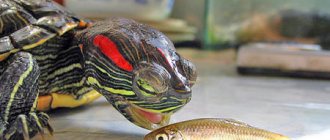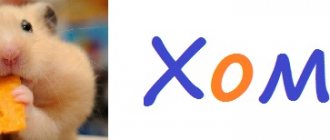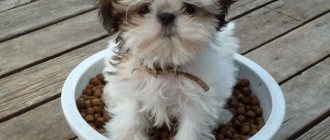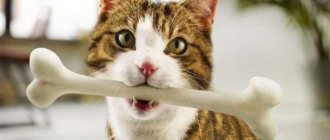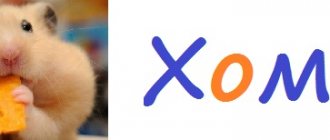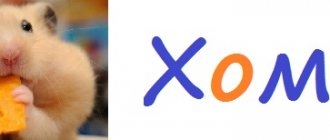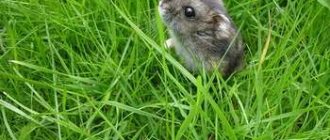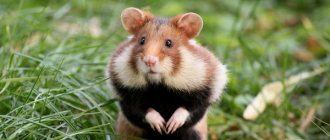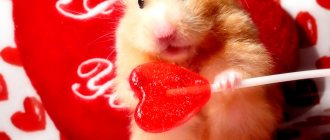- home
- Nutrition
07.04.2018
A proper diet is the source of vitality, energy and health for your hamster. This article will tell you what foods you can offer your pet at home and which you should not give. What to feed your Syrian hamster.
Proper diet for Syrian hamster
Domesticated Syrian hamsters are not capricious and picky; in the natural conditions of the wild, their relatives eat a wide variety of foods. The menu for domestic rodents should be as close as possible to the natural diet and based on the following components:
- cereal crops;
- succulent plant food;
- protein component.
The easiest and much safer way is to purchase a dry food mixture designed specifically for hamsters. Such compositions can be found in any pet store and even in a large supermarket; it is not forbidden to mix them yourself. However, the use of ready-made food does not relieve owners from the need to give rodents plant and animal food, albeit in much smaller quantities.
Syrian hamsters are usually fed twice a day (morning and evening); they are given no more than 25-30 g of grain mixture (a tablespoon) at a time. Moreover, at the first dose it is better to give a slightly smaller portion, and in the evening the main portion (60-70%). This is explained by the fact that hamsters' activity reaches its highest peak at nightfall (when they expend a lot of calories).
Alternation of feed and products
Veterinarians do not recommend keeping hamsters on dry mixtures alone; they must be alternated with other products (various cereals and vegetables). Instead of food, if it suddenly runs out, you can occasionally give bread (gray, black, rye, with bran, cereals, etc.). Small rodents should not be starved, as they have an intense metabolism, and long breaks in eating are extremely painful and harmful for them. The Syrian hamster is capable of not eating for 2-3 days, but it is still better not to allow such a situation and not to risk it.
Meeting a furry animal
The Syrian hamster is a rodent belonging to the hamster family. Its other name is “golden hamster”, which it received due to its reddish-yellow fur. Animals of this breed can be colored not only golden, but also white, brown, black, and silver. The classic Syrian hamster is short-haired, but currently long-haired variations of this species have also been bred. The length of the body of Syrian hamsters ranges from 13 to 18 cm, weight fluctuates around 100-200 g.
The rodent's body is stocky, its legs are short, its ears are rounded, its muzzle is short, its eyes resemble convex beads, and it has a short tail, which is not easy to find in the thick fur. The abdomen is lighter than the back, like all rodents. The hind feet have five toes, the front feet have four, and there is also a rudimentary fifth. A distinctive feature of hamsters is their cheek pouches; the Syrian breed also has them, and it uses them fully. The active phase of an animal’s life in nature occurs at night.
Before getting any pet - be it a turtle, snail, rabbit, jerboa, degu, guinea pig, siskin, crossbill, parrot - you should study the features of caring for it.
The animals are clean and hardy. They are active, funny and curious, become attached to their owner and can be trained, and do not show aggression towards people. Females have virtually no scent, but males prefer to carefully mark their territory.
First described in the late 18th century, the Syrian hamster has a long, fascinating and intricate history of distribution, breeding, study and selection.
Did you know? The Syrian hamster was listed in the Red Book as an endangered species.
How to choose food
The choice of food for rodents is extremely wide; it is extremely important to choose the most optimal composition. A good food grain-cereal mixture for Syrian hamsters should definitely include:
- oats, wheat;
- buckwheat, millet (preferably red);
- corn, shelled peas;
- peanuts, cashews;
- sunflower seed, alfalfa;
- flax, sesame;
- pumpkin seeds, etc.
Ready-made store-bought food intended for hamsters (Syrian and others) contains cereals and grains, with the addition of various seeds. It is welcome if they contain a protein component (sublimated granules: fish, chicken, shellfish, shrimp, veal, yeast, etc.). Many manufacturers add dried vegetables and fruits to feed mixtures, and some even further enrich them with minerals (P, Ca) and vitamins (E, A).
Before purchasing, you must carefully study the entire composition of the product. Ideally it should be like this:
- proteins - no less than 14%;
- fiber - 5-8%;
- fats - up to 8%.
The proportion of fat-containing components (nuts and seeds) should not exceed the recommended amount, since consuming large amounts of high-calorie foods by a hamster can lead to obesity.
High-quality food for Syrian hamsters must meet the following requirements:
- do not contain various dyes, flavor enhancers, preservatives and other artificial additives;
- there should not be any exotic fruits, as well as honey, sugar and salty ingredients;
- all grains must be whole and undamaged, free from dust, dirt, mold and other foreign matter;
- the packaging is sealed, with a good shelf life, without signs of opening or damage (preferably transparent so that its contents can be seen).
It is strictly contraindicated to use store-bought dry food intended for other categories of animals (birds, rabbits, etc.) to feed the Syrian hamster. The composition of these mixtures is designed for a specific type of animal; some components are absolutely unsuitable for hamsters and can cause significant harm (problems with the gastrointestinal tract, etc.).
What not to give
Rodents are considered omnivores. But some foods cannot be given to hamsters. Feeding hamsters the following foods can cause health problems and even be fatal.
Syrian hamsters should not be given the following foods: fats of any origin, salt, sugar, chemical additives, spices, pine needles, plant bulbs, sour fruits, berries and plants, citrus fruits, cabbage, mint, garlic, most dairy products, berry and fruit seeds, mushrooms , potato sprouts and peels, baked goods, food for birds or other animals, canned food and smoked meats.
The above products should be completely excluded from the animal’s diet. Adequate nutrition is a very important element of a comfortable and long life for a hamster.
What products are allowed and not allowed?
Proper nutrition for a Syrian hamster, like any other, should be well thought out, balanced, as complete as possible and as varied as possible. He eats almost everything, but there are quite a large number of foods that are completely contraindicated for him.
Cereals
In the daily diet of the Syrian hamster, cereals constitute the base (at least 30%), which cannot be replaced by anything. You can give:
- Buckwheat – preferably dry or soaked in warm water for 10-12 hours, but you can also boil it (in water);
- Wheat – best sprouted or cold soaked. Dry grain is poorly absorbed by the Syrian hamster;
- Oats – flakes (rolled oats) and grains (unpeeled if possible) are allowed. Sprouted oats are very useful for hamsters;
- Lentils - can be in any form (boiled and natural dry);
- Barley, slightly steamed;
- Barley, without hull.
It is not recommended to feed your Syrian hamster the following cereals:
- Rice is a heavy food that does not contain anything useful.
- Semolina – promotes weight gain, and contains practically no useful substances and microelements; it is an empty refined cereal.
- Millet - if you give it, then only unpeeled (millet) and a little.
Muesli should not be given to Syrian hamsters. In addition to cereals and pieces of fruit, they contain a lot of sugar, which is harmful to the health of rodents.
Vegetables
Both fresh and boiled vegetables have an important place in the daily diet of the Syrian hamster, but in fairly small quantities (40-50 g). Will be useful:
- pumpkin, zucchini, eggplant;
- radishes, turnips, carrots, beets;
- cucumber, sweet pepper (paprika);
- tomatoes (rarely, a couple of times a week);
- green beans.
All vegetables must be thoroughly washed and skinned (preferably). You cannot give rotten and stale fruits to Syrian hamsters, because then poisoning is guaranteed.
Preference is given to crops grown on your own plot, because store-bought products are grown using chemicals that are harmful to hamsters, and sometimes even deadly.
Prohibited, may cause harm to health with fatal outcome:
- onion garlic;
- cabbage;
- sorrel;
- radish, potatoes.
Fruits and berries
It is undoubtedly useful and even necessary to feed the Syrian hamster with fresh fruits and sometimes berries. After all, they are extremely rich in nutrients, various minerals and vitamins required for the normal functioning of the body. Useful and recommended:
- apples (12-15 g daily) fresh and dried;
- bananas (1-2 times a week, 8-10 g) fresh and dried;
- fresh pears (10-12 twice a week), dried (every 10-14 days, 5-6 g);
- peach, apricot, nectarine (1-2 times a month, 5-6 g);
Berries are relevant in a hamster’s diet, but they are added rarely and little by little (half or a whole berry once a week):
- blackberries, raspberries;
- strawberries, wild strawberries;
- blueberries;
- rowan;
- red and white currants;
- gooseberries, lingonberries, blueberries, grapes and cherries, sweet cherries (necessarily seedless).
The following are prohibited:
- any citrus fruits (pamelo, orange, tangerine, etc.);
- exotic fruits from the tropics (coconut, kiwi, pineapple, etc.);
- melon watermelon;
- sea buckthorn, barberry;
- pomegranate seeds.
Dairy products
Sweet dairy products, as well as those containing dyes, flavors and other synthetic additives, are strictly prohibited for Syrian hamsters. They can only:
- low-fat cottage cheese - twice a month in small portions (10-15 g);
- yogurt - once a month;
- cheese with the lowest fat content (1%) - 5-6 g once a month.
Due to the increased fat content, it is harmful to give hamsters:
- milk, sour cream, cream;
- butter, yogurt, kefir;
- cheeses, also with mold.
An adult hamster's body cannot digest milk. This product is necessary only for pregnant females, orphans left without a mother, and individuals weakened by illness.
Other products
The protein component is extremely important in the diet of the Syrian hamster; they are given this food 2-3 times a week (15-20 g each). As an addition to the main menu use:
- boiled chicken (without skin and fat);
- lean meat;
- eggs (preferably quail);
- boiled fish (boneless and lean);
- insects (ants, worms, flies, grasshoppers, etc.), sold only in pet stores;
- freshwater crustaceans, gammarus.
Legumes (chickpeas, beans, peas) contain a lot of protein. They are given boiled or soaked.
Hamsters are very fond of various nuts and seeds; they often choose them from the food mixture, leaving everything else in the bowl. But, since they are very fatty, you can’t give them a lot (no more than 1-2 pieces are allowed every 10-15 days), you can:
- shelled walnuts, peanuts;
- hazelnuts (with the permission of the veterinarian);
- cashews, pine nuts;
- sesame;
- sunflower, pumpkin and watermelon seeds.
Extremely undesirable and sometimes even deadly for Syrian hamsters:
- brazil nut;
- almond;
- acorns.
In the daily menu compiled for the Syrian hamster, a significant part should be fresh green food. Allowed useful plants:
- Garden greens: lawn grass (only bluegrass is allowed), vegetable tops (turnips, beets, carrots), parsley, celery, dill, lettuce;
- Weeds: young growth of nettle, dandelion (leaves without a central vein, strong choleretic, not too much), wheatgrass;
- Medicinal plants: knotweed, petals of rosaceae (rose hips, roses, etc.), plantain;
- Forage crops: wheat or oat sprouts, alfalfa, clover, alfalfa.
- Young leaves of garden fruit and berry crops and some trees: pear, apple, birch, cherry, willow, maple, etc.
- hay (in winter).
Hamsters should not be given all greens indiscriminately; some plants should never be given:
- sorrel, potato tops (and sprouts);
- wormwood (can only be done as directed by a veterinarian);
- mint, tarragon and other herbs;
- regular street grass.
Greens should be collected only in clean places, as far away from highways and busy roads as possible. Before use, the herb should be thoroughly rinsed in running water and dried.
To grind down the front teeth, which constantly grow throughout their lives, the Syrian hamster must be provided with branches of tree crops:
- birch, maple, poplar;
- ash, willow, oak, beech;
- apple trees, pears, cherries.
It is forbidden to give hamsters twig material from coniferous crops, they are harmful to rodents (as they are resinous).
Also, the following products are completely contraindicated for hamsters:
- flour, bakery;
- sausage products;
- salty and sweet (especially chocolate);
- food from the common table;
- pasta (dry);
- canned food;
- smoked, fatty, spicy and spicy.
Walking around the apartment
A hamster walking around the apartment faces many dangers:
- He can pick up an infection brought by people or other animals with street dust.
- Burying itself under a carpet or blanket, or simply tucked under your feet, a small animal runs the risk of being crushed or slammed by a door.
- Being a flatland dweller, the rodent is completely devoid of fear of heights, which can play a cruel joke on it.
- An animal can pick up something from the floor that is inedible and/or poisonous to it; how much does such a baby need?
- A rodent can chew through wires, at a minimum damaging them and at a maximum receiving an electric shock, even a small voltage of which can be fatal.
- If there is another animal in the house, especially a predator, it poses a constant potential threat to the rodent, even if they coexist peacefully in the same space, so leaving the hamster alone with other pets is undesirable.
It is relatively safe for a hamster to walk around the apartment in a special walking ball, but it should still be released under supervision and for a short time.
It is better to organize a pen with an area of a square meter for the hamster, in which there will be a fence that does not let him outside, and the pen itself will be equipped with toys and hamster devices that can entertain the pet and provide proper physical activity.
Delicacy
A hamster's diet may seem monotonous and boring. after all, it is dominated by ordinary grains and vegetable crops. In addition to the main menu, the Syrian hamster can be pampered with treats that he can consume without any harm to his own health:
- fruit chips;
- dried fruits (raisins, dried apricots);
- popcorn (unsalted and without butter);
- pink petals.
Stores that sell pet supplies sell special tasty treats for hamsters:
- grain sticks, balls, houses, etc.;
- fruit and nut mixtures;
- tartlets with filling;
- a cookie treat (not to be confused with homemade cookies).
You can prepare delicious treats with your own hands:
- Roll banana pulp, raisins and oatmeal into balls. You can add grated carrots and apples.
- Add the usual grain mixture to the beaten egg white, mix and form small cakes. Bake at +30...+60 °C in the oven until hardened.
- Prepare a salad from fresh herbs (clover, etc.) and finely chopped walnuts.
- String tasty pieces (vegetables, fruits, etc.) onto a toothpick.
Syrian hamsters will appreciate and with great pleasure treat themselves to grain sprouted into grass.
Types of fur of the royal rodent
There are 3 main varieties of Syrian hamsters based on their coat type.
Satin . Classic shorthaired Syrians. Often the coat is "glossy", which makes the hamster shine in the light.
Long-haired . A detachment of royal rodents with long hair (individuals with a hairstyle 8-10 cm long are known). Often these Syrian hamsters are also called Angora or Persian. The abundant coat requires special care, so we have dedicated separate material on the website to Angora pets.
And I'm not the shaggiest yet!
Rex. Bred relatively recently, they are covered with thick wavy hair that looks like curls.
Features of feeding a pregnant or lactating woman
While bearing and feeding offspring, the female Syrian hamster needs to eat heavily. During this crucial period, she requires a slightly larger amount of nutrients. A complex of vitamin and mineral supplements should also be introduced. The diet includes more fresh greens, sprouted grains and high-protein foods. Food should be as varied as possible and definitely healthy.
Veterinarians advise putting a mineral pebble (sold at any veterinary pharmacy), a piece of chalk, coal or calcium gluconate inside the cage as a treat. A pregnant or lactating female hamster usually has an increased appetite and she usually becomes very anxious when food is scarce. To avoid negative consequences for her and her offspring, it is recommended to increase the amount of feed given. It is better if there is always food in the bowl, but it must be fresh.
What to feed small hamsters
For the first four weeks of their lives, small hamsters feed exclusively on their mother's milk. There is no need to feed them additionally. Newborn hamsters left without a mother (or in the absence of milk from her) are fed with soy-based infant formula for the smallest (from birth 0+). You can also feed it with a cat milk replacer.
Once they reach the age of one month, they begin to be offered other food. The digestive system of babies is still very delicate, so the diet of adult hamsters is not suitable for them.
Regular grain food is poured into a bowl so that the kids can rummage through it and choose what they like. It is better not to give nuts, fruits and other treats for now, but to put them aside for later (until he grows up). Hamsters should be fed milk formula and porridge; you can mix steamed oatmeal or buckwheat flakes with baby puree (from various vegetables or meat). Gradually, one by one, other products are introduced: sprouted grains and young shoots, fresh herbs.
Where to put a house in an apartment
Not every corner of your apartment is suitable for housing a hamster.
- This is a nocturnal animal; day for it is a time of sleep and rest. It is better if the cage is located in a place that is not very visited during the day. Despite the need for a quiet place, it is desirable that the animal is in sight.
- Nocturnal rodents are particularly sensitive to vibrations, so you should place your pet away from the TV, computer, washing machine and other devices that make noise.
- Their eyes are not adapted to daylight and bright light, the pupil does not contract, so a place near a window or other light source is not suitable for a hamster; the lighting will constantly harm the animal’s vision.
- For the convenience of observing the life and habits of your pet - you get him in order to enjoy communication - it is better to place the cage at eye level: on some table or cabinet.
- It is very desirable to make two walls of the cage opaque: one is usually placed against the wall, and the second is screened.
- The temperature should not go beyond 12-25°C. If it temporarily becomes colder, it is unlikely to cause harm to the animal, but an increase in temperature will speed up already rapid metabolic processes, which will not benefit the animal’s life expectancy. Based on what has been said, we can conclude: it is impossible for the cage to stand near a heat source: a battery or a heater. It is advisable to avoid temperature changes.
Important! The Syrian hamster hibernates if the air temperature drops below 8
°C
, it is better to avoid this load on his body.
- The cage should be located away from drafts and smoking areas, but it is important that the space is ventilated and there is no air stagnation.
- It is absolutely unacceptable for another animal, such as a cat or dog, to have access to a rodent. Predators can be very inventive in overcoming obstacles in the form of latches and the like, and for a hamster such a neighborhood can end very badly.
- There should be no curtains, clothes, indoor plants or other objects and materials near the cage that the animal can drag inside.
Is it possible to bathe
Nature does not provide for hamsters to bathe in water; they take care of themselves by washing their paws and cleaning their fur several times a day.
During the short life of Syrian hamsters, it is unlikely that the owners will need to bathe them in water, but in exceptional cases this can be done. Bathing is carried out very quickly under running warm water using zoo shampoo for rodents, without wetting the head and face. After bathing, the animal should be dried as quickly as possible: blot the fur with water-absorbing material and dry with a hair dryer with a warm stream of air.
Bathing your pet can be fraught with stress, at the very least, and if it becomes hypothermic, it can become seriously ill.
